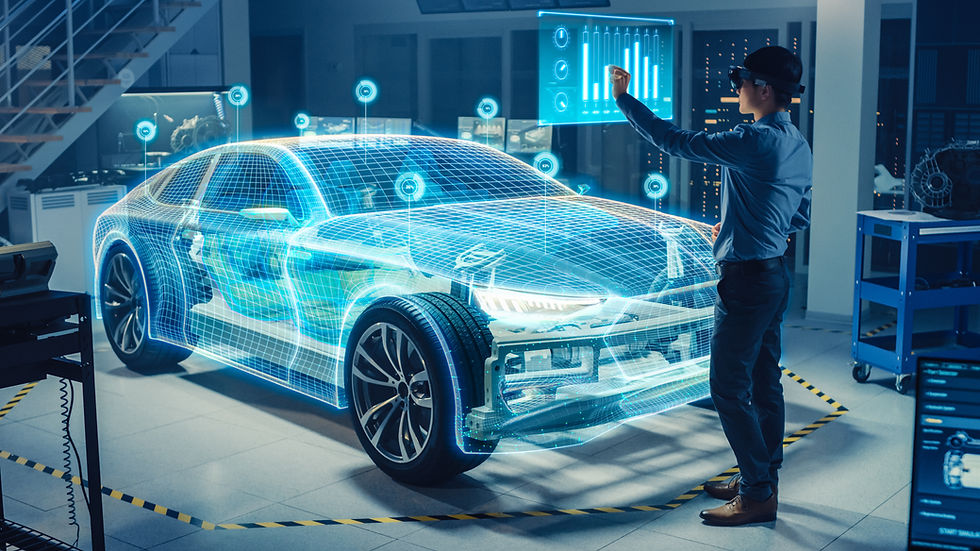The Future is Here: 5 Unexpected Ways 3D Virtual Tours are Transforming Industries
- Louis Pont
- May 23, 2024
- 4 min read
Updated: Aug 5
We've all experienced the convenience of 3D virtual tours. From exploring dream vacation destinations to navigating real estate listings, this technology has revolutionised the way we experience places remotely. But the impact of 3D virtual tours extends far beyond the realm of tourism and marketing. They are quietly transforming entire industries, fostering deeper learning, enhancing healthcare delivery, and streamlining collaboration across vast distances. Let's delve into five unexpected ways 3D virtual tours are shaping the future:
1. Revolutionising Education:
Imagine stepping back in time and exploring the Great Pyramids of Giza in their prime, or dissecting a virtual frog in intricate detail. 3D virtual tours are breaking down the limitations of traditional classrooms, transporting students to the heart of historical sites, scientific wonders, and even the human body.
History Comes Alive: Interactive 3D tours of ancient landmarks, battlefields, and cultural centers allow students to explore historical events in a captivating way. Imagine virtually walking through the Colosseum in its glory days, or touring the ruins of Pompeii, gaining a deeper understanding of these bygone eras.
Science in Action: Complex scientific concepts become more accessible with 3D virtual tours. Imagine taking a virtual tour inside the human body, examining different organ systems in detail, or exploring the vastness of the cosmos through a 3D model of the solar system.
Engaging the Senses: 3D virtual tours can incorporate multimedia elements like audio narration, historical reenactments, and interactive quizzes, creating a truly immersive learning experience that caters to diverse learning styles.

2. Transforming Healthcare:
The healthcare industry is rapidly embracing the power of 3D virtual tours. This technology is improving patient education, streamlining remote consultations, and enhancing hospital operations.
Empowering Patients: 3D virtual tours can be used to educate patients about upcoming procedures, allowing them to virtually navigate the surgical site or treatment area. This reduces anxiety and fosters informed decision-making.
Remote Consultations and Telemedicine: 3D virtual tours can be a valuable tool for remote consultations. Doctors can utilise them to virtually examine patients in remote locations, assess injuries, and even perform preliminary diagnoses.
Virtual Hospital Tours: 3D tours can showcase hospital facilities for new patients, reducing anxiety and providing a sense of familiarity before their visit. This can be particularly helpful for pediatric patients or those with specific needs.

3. Boosting Remote Collaboration:
In today's globalised world, teams often work across different continents and time zones. 3D virtual tours are bridging these geographical gaps, fostering seamless collaboration on complex projects.
Virtual Project Sites: 3D virtual tours can be used to create interactive models of construction sites, engineering projects, or product designs. Team members from all over the world can virtually "walk" through the model, identify potential issues, and collaborate in real-time using online annotations and communication tools.
Improved Design Communication: 3D virtual tours allow architects, engineers, and designers to communicate their ideas more effectively. Detailed 3D models with high-resolution visuals and interactive features enable stakeholders to visualize the project in its entirety, leading to better decision-making and fewer revisions.
Streamlined Remote Training: 3D virtual tours can be a valuable tool for remote training programs. Imagine training new employees on complex machinery or production lines through interactive 3D models, eliminating the need for travel and offering a safe and controlled learning environment.

4. Redefining Retail:
The retail industry is also harnessing the power of 3D virtual tours. This technology is transforming the way customers experience products and interact with brands.
Enhanced Product Visualisation: 3D virtual tours allow customers to take virtual tours of physical stores, browse product selections from anywhere in the world, and examine items in detail from all angles. This can be particularly beneficial for furniture, homeware, or large equipment purchases.
Improved Customer Experience: Retailers can use 3D virtual tours to showcase the ambience and layout of their stores, allowing customers to plan their shopping trips more efficiently. Virtual tours can also be used to create interactive showrooms, where customers can explore product features and functionalities in an immersive way.
Streamlined Online Sales: High-quality 3D virtual tours can significantly improve conversion rates for online stores. By providing customers with a realistic and interactive product experience, retailers can reduce buyer's remorse and boost online sales.

5. Revolutionising Travel and Tourism:
While 3D virtual tours can't replace the thrill of physical travel, they can be a powerful tool for inspiring wanderlust and enhancing the travel experience.
Pre-Trip Planning: 3D virtual tours allow travellers to virtually explore destinations before they book their trip. Imagine taking a virtual tour of the Louvre Museum in Paris, navigating the grand halls and zooming in on specific artworks to plan your itinerary. This can help travellers make informed decisions about their must-see sights and optimise their time.
Enhanced Accessibility: 3D virtual tours can open up travel experiences to people with mobility limitations or those who face geographical restrictions. Virtual tours of historical landmarks, natural wonders, or even cultural events can provide a sense of immersion and cultural exchange, even if physical travel isn't possible.
Virtual Reality Integration: As virtual reality technology continues to evolve, 3D virtual tours can be integrated with VR headsets to create even more immersive travel experiences. Imagine virtually exploring the Great Barrier Reef, swimming alongside vibrant fish and coming face-to-face with marine life, all from the comfort of your home.

Beyond the Unexpected:
These are just a few examples of how 3D virtual tours are transforming industries. As the technology continues to evolve, we can expect even more innovative applications to emerge. From virtual reality surgical simulations to 3D tours of off-planet locations, the possibilities are truly endless.
The Future is Immersive:
3D virtual tours are ushering in a new era of immersive experiences. They are not just replicating physical spaces; they are creating entirely new learning environments, healthcare delivery models, and collaboration opportunities. As this technology becomes more accessible and affordable, we can expect to see its impact continue to ripple across industries, shaping the way we learn, work, and interact with the world around us.






Comments